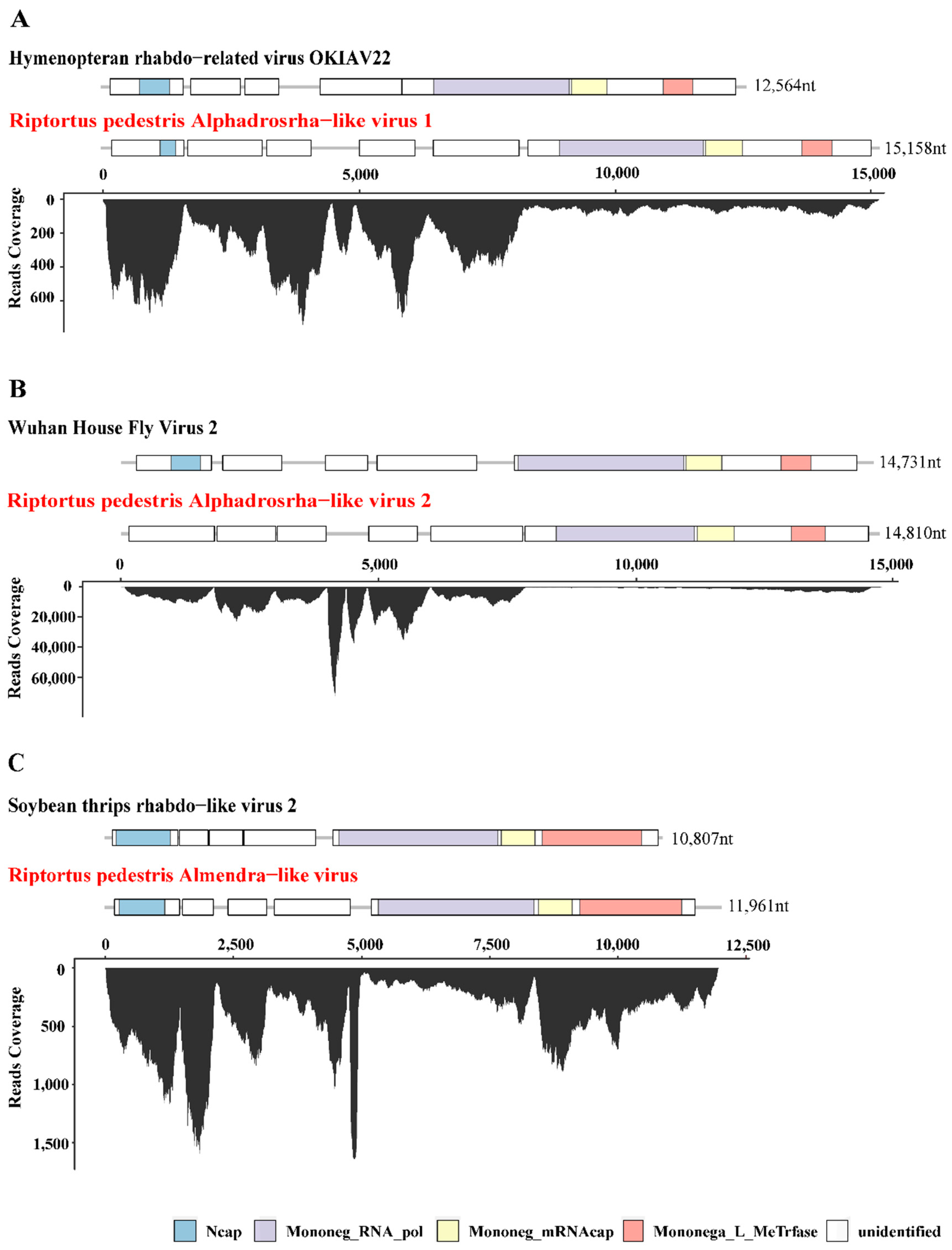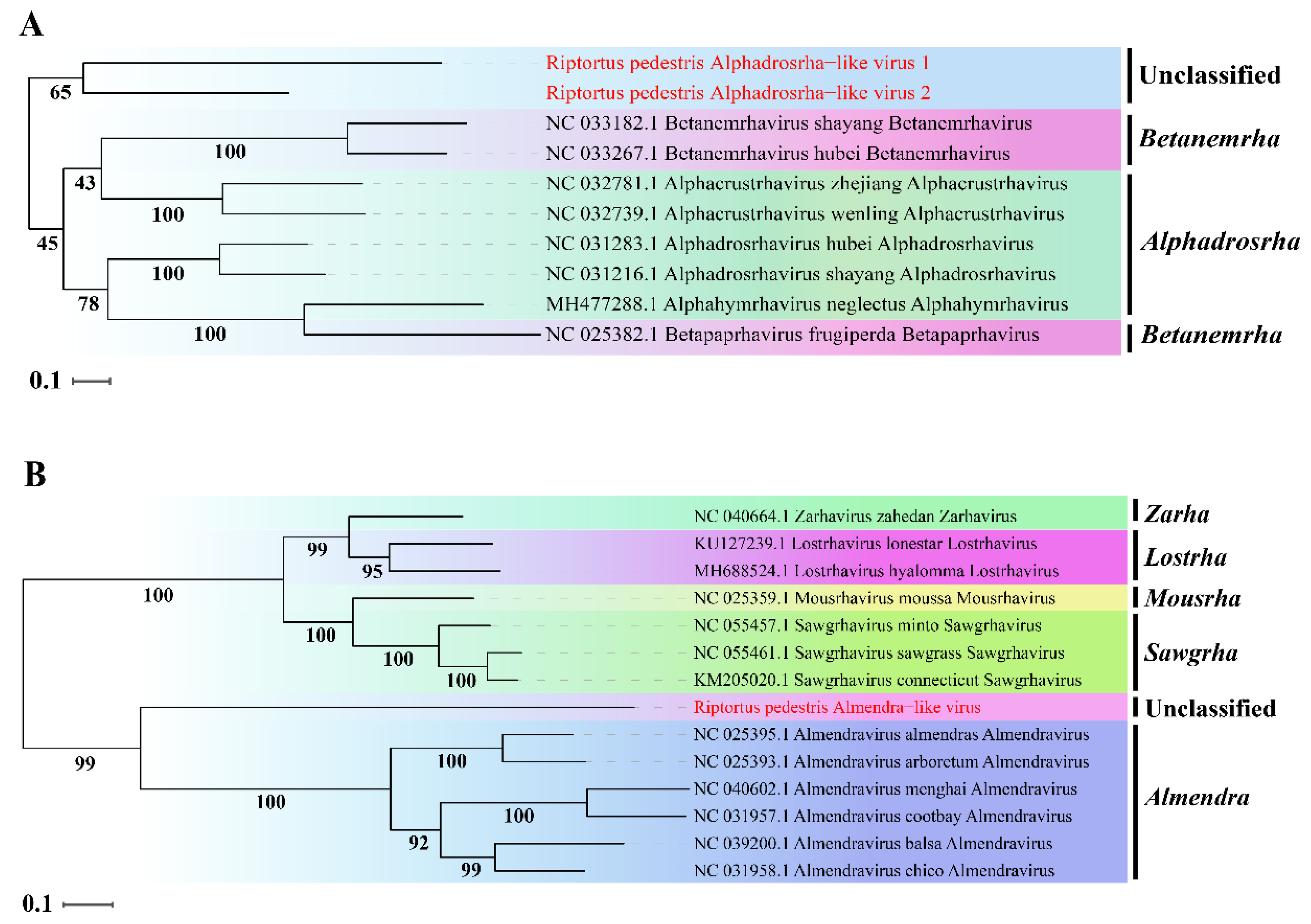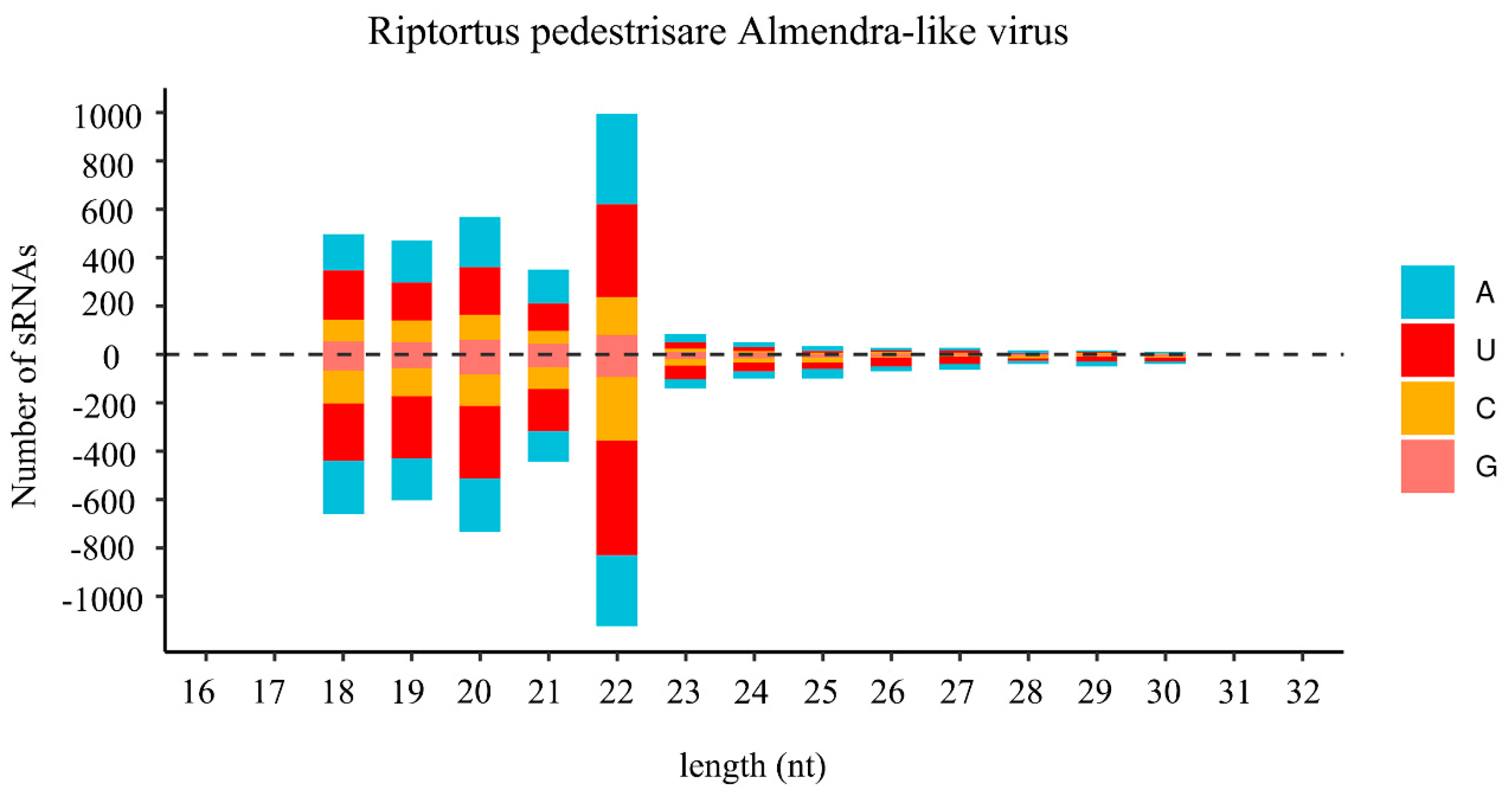The Characterization of Three Novel Insect-Specific Viruses Discovered in the Bean Bug, Riptortus pedestris
Abstract
:1. Introduction
2. Materials and Methods
2.1. Field Insect Samples
2.2. RNA Extraction
2.3. RNA-Sequencing
2.4. RNA Virus Discovery
2.5. Genome Annotation and Transcript Coverage
2.6. Small RNA (sRNA) Sequencing and Analysis
2.7. Phylogenetic Analysis
3. Results
3.1. Transcriptome Assembly and Virome Analysis in R. pedestris
3.2. Genomic Structures Analysis of Three Novel Viruses of R. pedestris
3.3. Phylogenetic Analysis of Three Novel Viruses of R. pedestris
3.4. Virus-Derived Small Interfering RNA (vsiRNA) Analysis of R. pedestris Responsive to Virus Infection
4. Discussion
5. Conclusions
Supplementary Materials
Author Contributions
Funding
Institutional Review Board Statement
Informed Consent Statement
Data Availability Statement
Conflicts of Interest
References
- Li, K.; Zhang, X.; Guo, J.; Penn, H.; Wu, T.; Li, L.; Jiang, H.; Chang, L.; Wu, C.; Han, T. Feeding of Riptortus pedestris on soybean plants, the primary cause of soybean staygreen syndrome in the Huang-Huai-Hai river basin. Crop J. 2019, 7, 360–367. [Google Scholar] [CrossRef]
- Bakken, A.J.; Schoof, S.C.; Bickerton, M.; Kamminga, K.L.; Jenrette, J.C.; Malone, S.; Abney, M.A.; Herbert, D.A.; Reisig, D.; Kuhar, T.P.; et al. Occurrence of brown marmorated stink bug (Hemiptera: Pentatomidae) on wild hosts in nonmanaged woodlands and soybean fields in north carolina and virginia. Environ. Entomol. 2015, 44, 1011–1021. [Google Scholar] [CrossRef] [PubMed] [Green Version]
- Huang, H.J.; Ye, Y.X.; Ye, Z.X.; Yan, X.T.; Wang, X.; Wei, Z.Y.; Chen, J.P.; Li, J.M.; Sun, Z.T.; Zhang, C.X. Chromosome-level genome assembly of the bean bug Riptortus pedestris. Mol. Ecol. Resour. 2021, 21, 2423–2436. [Google Scholar] [CrossRef] [PubMed]
- Rahman, M.M.; Lim, U.T. Evaluation of mature soybean pods as a food source for two pod-sucking bugs, Riptortus pedestris (Hemiptera: Alydidae) and Halyomorpha halys (Hemiptera: Pentatomidae). PLoS ONE 2017, 12, e0176187. [Google Scholar] [CrossRef] [Green Version]
- Zogli, P.; Pingault, L.; Grover, S.; Louis, J. Ento(o)mics: The intersection of ‘omic’ approaches to decipher plant defense against sap-sucking insect pests. Curr. Opin. Plant Biol. 2020, 56, 153–161. [Google Scholar] [CrossRef]
- Jung, M.; Lee, D.H. Characterization of overwintering behaviors and sites of bean bug, Riptortus pedestris (Hemiptera: Alydidae), under laboratory and field conditions. Environ. Entomol. 2018, 47, 1280–1286. [Google Scholar] [CrossRef]
- Kim, E.; Park, C.G.; Lim, U.T. Evaluation of three plant seeds as potential pre-season diets for Riptortus pedestris. J. Asia Pac. Entomol. 2014, 17, 521–524. [Google Scholar] [CrossRef]
- Zhang, X.; Wang, M.; Wu, T.; Wu, C.; Jiang, B.; Guo, C.; Han, T. Physiological and molecular studies of staygreen caused by pod removal and seed injury in soybean. Crop J. 2016, 4, 435–443. [Google Scholar] [CrossRef] [Green Version]
- Cheng, R.; Mei, R.; Yan, R.; Chen, H.; Miao, D.; Cai, L.; Fan, J.; Li, G.; Xu, R.; Lu, W.; et al. A new distinct geminivirus causes soybean stay-green disease. Mol. Plant 2022, 15, 927–930. [Google Scholar] [CrossRef]
- Wang, X.; Wang, M.; Wang, L.; Feng, H.; He, X.; Chang, S.; Wang, D.; Wang, L.; Yang, J.; An, G.; et al. Whole-plant microbiome profiling reveals a novel geminivirus associated with soybean stay-green disease. Plant Biotechnol. J. 2022, 20, 2159–2173. [Google Scholar] [CrossRef]
- Li, Q.; Zhang, Y.; Lu, W.; Han, X.; Yang, L.; Shi, Y.; Li, H.; Chen, L.; Liu, Y.; Yang, X.; et al. Identification and characterization of a new geminivirus from soybean plants and determination of V2 as a pathogenicity factor and silencing suppressor. BMC Plant Biol. 2022, 22, 362. [Google Scholar] [CrossRef] [PubMed]
- Li, W.; Gao, Y.; Hu, Y.; Chen, J.; Zhang, J.; Shi, S. Field cage assessment of feeding damage by Riptortus pedestris on soybeans in China. Insects 2021, 12, 255. [Google Scholar] [CrossRef] [PubMed]
- van Aerle, R.; Santos, E.M. Advances in the application of high-throughput sequencing in invertebrate virology. J. Invertebr. Pathol. 2017, 147, 145–156. [Google Scholar] [CrossRef] [PubMed]
- Bolling, B.G.; Weaver, S.C.; Tesh, R.B.; Vasilakis, N. Insect-specific virus discovery: Significance for the arbovirus community. Viruses 2015, 7, 4911–4928. [Google Scholar] [CrossRef] [PubMed] [Green Version]
- Vasilakis, N.; Forrester, N.L.; Palacios, G.; Nasar, F.; Savji, N.; Rossi, S.L.; Guzman, H.; Wood, T.G.; Popov, V.; Gorchakov, R.; et al. Negevirus: A proposed new taxon of insect-specific viruses with wide geographic distribution. J. Virol. 2013, 87, 2475–2488. [Google Scholar] [CrossRef] [Green Version]
- Nouri, S.; Matsumura, E.E.; Kuo, Y.W.; Falk, B.W. Insect-specific viruses: From discovery to potential translational applications. Curr. Opin. Virol. 2018, 33, 33–41. [Google Scholar] [CrossRef]
- Roossinck, M.J.; Bazán, E.R. Symbiosis: Viruses as intimate partners. Annu. Rev. Virol. 2017, 4, 123–139. [Google Scholar] [CrossRef]
- Wu, N.; Zhang, P.; Liu, W.; Cao, M.; Massart, S.; Wang, X. Complete genome sequence and characterization of a new iflavirus from the small brown planthopper (Laodelphax striatellus). Virus Res. 2019, 272, 197651. [Google Scholar] [CrossRef]
- Kondo, H.; Fujita, M.; Hisano, H.; Hyodo, K.; Andika, I.B.; Suzuki, N. Virome analysis of aphid populations that infest the barley field: The discovery of two novel groups of nege/kita-Like viruses and other novel RNA viruses. Front. Microbiol. 2020, 11, 509. [Google Scholar] [CrossRef]
- Moon, J.S.; Domier, L.L.; McCoppin, N.K.; D’Arcy, C.J.; Jin, H. Nucleotide sequence analysis shows that Rhopalosiphum padi virus is a member of a novel group of insect-infecting RNA viruses. Virology 1998, 243, 54–65. [Google Scholar] [CrossRef]
- Ryabov, E.V. A novel virus isolated from the aphid Brevicoryne brassicae with similarity to Hymenoptera picorna-like viruses. J. Gen. Virol. 2007, 88, 2590–2595. [Google Scholar] [CrossRef] [PubMed]
- Shi, M.; Lin, X.D.; Vasilakis, N.; Tian, J.H.; Li, C.X.; Chen, L.J.; Eastwood, G.; Diao, X.N.; Chen, M.H.; Chen, X.; et al. Divergent viruses discovered in arthropods and vertebrates revise the evolutionary history of the flaviviridae and related viruses. J. Virol. 2016, 90, 659–669. [Google Scholar] [CrossRef] [Green Version]
- Teixeira, M.; Sela, N.; Ng, J.; Casteel, C.L.; Peng, H.C.; Bekal, S.; Girke, T.; Ghanim, M.; Kaloshian, I. A novel virus from Macrosiphum euphorbiae with similarities to members of the family Flaviviridae. J. Gen. Virol. 2016, 97, 1261–1271. [Google Scholar] [CrossRef] [PubMed]
- Teixeira, M.A.; Sela, N.; Atamian, H.S.; Bao, E.; Chaudhary, R.; MacWilliams, J.; He, J.; Mantelin, S.; Girke, T.; Kaloshian, I. Sequence analysis of the potato aphid Macrosiphum euphorbiae transcriptome identified two new viruses. PLoS ONE 2018, 13, e0193239. [Google Scholar] [CrossRef] [PubMed] [Green Version]
- Yang, Y.T.; Nai, Y.S.; Lee, S.J.; Lee, M.R.; Kim, S.; Kim, J.S. A novel picorna-like virus, Riptortus pedestris virus-1 (RiPV-1), found in the bean bug, R. pedestris, after fungal infection. J. Invertebr. Pathol. 2016, 141, 57–65. [Google Scholar] [CrossRef]
- Yang, Y.T.; Lee, S.J.; Nai, Y.S.; Kim, J.S. Complete Genome Sequence of a Novel Putative RNA Virus, RiPV-2, from the Bean Bug Riptortus pedestris. Microbiol. Resour. Announc. 2020, 9, e01584-19. [Google Scholar] [CrossRef]
- Grabherr, M.G.; Haas, B.J.; Yassour, M.; Levin, J.Z.; Thompson, D.A.; Amit, I.; Adiconis, X.; Fan, L.; Raychowdhury, R.; Zeng, Q.; et al. Full-length transcriptome assembly from RNA-Seq data without a reference genome. Nat. Biotechnol. 2011, 29, 644–652. [Google Scholar] [CrossRef] [Green Version]
- Huang, H.J.; Ye, Z.X.; Wang, X.; Yan, X.T.; Zhang, Y.; He, Y.J.; Qi, Y.H.; Zhang, X.D.; Zhuo, J.C.; Lu, G.; et al. Diversity and infectivity of the RNA virome among different cryptic species of an agriculturally important insect vector: Whitefly Bemisia tabaci. NPJ Biofilms Microbiomes 2021, 7, 43. [Google Scholar] [CrossRef]
- Buchfink, B.; Xie, C.; Huson, D.H. Fast and sensitive protein alignment using DIAMOND. Nat. Methods 2015, 12, 59–60. [Google Scholar] [CrossRef]
- Langmead, B.; Salzberg, S.L. Fast gapped-read alignment with Bowtie 2. Nat. Methods 2012, 9, 357–359. [Google Scholar] [CrossRef]
- Li, H.; Handsaker, B.; Wysoker, A.; Fennell, T.; Ruan, J.; Homer, N.; Marth, G.; Abecasis, G.; Durbin, R.; 1000 Genome Project Data Processing Subgroup. The sequence alignment/map format and SAMtools. Bioinformatics 2009, 25, 2078–2079. [Google Scholar] [CrossRef] [PubMed] [Green Version]
- Langmead, B.; Trapnell, C.; Pop, M.; Salzberg, S.L. Ultrafast and memory-efficient alignment of short DNA sequences to the human genome. Genome Biol. 2009, 10, R25. [Google Scholar] [CrossRef] [PubMed] [Green Version]
- Katoh, K.; Standley, D.M. MAFFT multiple sequence alignment software version 7: Improvements in performance and usability. Mol. Biol. Evol. 2013, 30, 772–780. [Google Scholar] [CrossRef] [PubMed] [Green Version]
- Talavera, G.; Castresana, J. Improvement of phylogenies after removing divergent and ambiguously aligned blocks from protein sequence alignments. Syst. Biol. 2007, 56, 564–577. [Google Scholar] [CrossRef] [Green Version]
- Tesh, R.B.; Bolling, B.G.; Guzman, H.; Popov, V.L.; Wilson, A.; Widen, S.G.; Wood, T.G.; Walker, P.J.; Vasilakis, N. Characterization of Port Bolivar virus, a novel entomobirnavirus (Birnaviridae) isolated from mosquitoes collected in East Texas, USA. Viruses 2020, 12, 390. [Google Scholar] [CrossRef] [Green Version]
- Darriba, D.; Posada, D.; Kozlov, A.M.; Stamatakis, A.; Morel, B.; Flouri, T. ModelTest-NG: A new and scalable tool for the selection of DNA and protein evolutionary models. Mol. Biol. Evol. 2020, 37, 291–294. [Google Scholar] [CrossRef] [Green Version]
- Kozlov, A.M.; Darriba, D.; Flouri, T.; Morel, B.; Stamatakis, A. RAxML-NG: A fast, scalable and user-friendly tool for maximum likelihood phylogenetic inference. Bioinformatics 2019, 35, 4453–4455. [Google Scholar] [CrossRef] [Green Version]
- Walker, P.J.; Blasdell, K.R.; Calisher, C.H.; Dietzgen, R.G.; Kondo, H.; Kurath, G.; Longdon, B.; Stone, D.M.; Tesh, R.B.; Tordo, N.; et al. ICTV virus taxonomy profile: Rhabdoviridae. J. Gen. Virol. 2018, 99, 447–448. [Google Scholar] [CrossRef]
- Li, L.L.; Ye, Z.X.; Chen, J.P.; Zhang, C.X.; Huang, H.J.; Li, J.M. Characterization of two novel insect-specific viruses discovered in the green leafhopper, Cicadella viridis. Insects 2022, 13, 378. [Google Scholar] [CrossRef]
- Szymkowiak, P.; Tryjanowski, P.; Winiecki, A.; Grobelny, S.; Konwerski, S. Habitat differences in the food composition of the wasplike spider Argiope bruennichi (Scop.) (Aranei: Araneidae) in Poland. Belg. J. Zool. 2005, 135, 33–37. [Google Scholar]
- Ludy, C. Prey selection of orb-web spiders (Araneidae) on field margins. Agric. Ecosyst. Environ. 2007, 119, 368–372. [Google Scholar] [CrossRef]
- Cobbin, J.C.; Charon, J.; Harvey, E.; Holmes, E.C.; Mahar, J.E. Current challenges to virus discovery by meta-transcriptomics. Curr. Opin. Virol. 2021, 51, 48–55. [Google Scholar] [CrossRef] [PubMed]
- Shahhosseini, N.; Luhken, R.; Jost, H.; Jansen, S.; Borstler, J.; Rieger, T.; Kruger, A.; Yadouleton, A.; de Mendonca Campos, R.; Cirne-Santos, C.C.; et al. Detection and characterization of a novel rhabdovirus in Aedes cantans mosquitoes and evidence for a mosquito-associated new genus in the family Rhabdoviridae. Infect. Genet. Evol. 2017, 55, 260–268. [Google Scholar] [CrossRef]
- Dietzgen, R.G.; Kondo, H.; Goodin, M.M.; Kurath, G.; Vasilakis, N. The family Rhabdoviridae: Mono- and bipartite negative-sense RNA viruses with diverse genome organization and common evolutionary origins. Virus Res. 2017, 227, 158–170. [Google Scholar] [CrossRef] [PubMed] [Green Version]
- Contreras, M.A.; Eastwood, G.; Guzman, H.; Popov, V.; Savit, C.; Uribe, S.; Kramer, L.D.; Wood, T.G.; Widen, S.G.; Fish, D.; et al. Almendravirus: A proposed new genus of Rhabdoviruses isolated from mosquitoes in tropical regions of the Americas. Am. J. Trop. Med. Hyg. 2017, 96, 100–109. [Google Scholar] [CrossRef] [PubMed] [Green Version]
- Kechin, A.; Boyarskikh, U.; Kel, A.; Filipenko, M. cutPrimers: A new tool for accurate cutting of primers from reads of targeted next generation sequencing. J. Comput. Biol. 2017, 24, 1138–1143. [Google Scholar] [CrossRef]



| Temporary Virus Name | Collection Area | Sequence Length (nt) | Coverage | E-Value | Homologous Virus (Genome Size, nt) | Protein Identities | Virus Family | Virus Genus |
|---|---|---|---|---|---|---|---|---|
| Riptortus pedestris virus-1 Isolate AH-SZ | AH-SZ | 10,429 | 17× | 0.0 | Riptortus pedestris virus-1 (10,527) | 96.29% | Unassigned | Unassigned |
| Riptortus pedestris virus-1 Isolate AH-HF | AH-HF | 10,492 | 13× | 0.0 | 96.30% | |||
| Riptortus pedestris virus-1 Isolate AH-FY | AH-FY | 10,161 | 16× | 0.0 | 96.30% | |||
| Guiyang srgiope bruennichi iflavirus 1 Isolate SD-HZ | SD-HZ | 7711 | 74× | 0.0 | Guiyang srgiope bruennichi iflavirus 1 (10,414) | 94.64% | Iflaviridae | Iflavirus |
| Guiyang srgiope bruennichi iflavirus 1 Isolate SD-JN | SD-JN | 8260 | 66× | 0.0 | 94.75% | |||
| Riptortus pedestris virus-2 Isolate SD-JN | SD-JN | 10,021 | 8151× | 0.0 | Riptortus pedestris virus-2(9915) | 98.90% | Unassigned | Unassigned |
| Riptortus pedestris Reoviridae-like virus (RpRLv) | AH-SZ | 2249 | 13× | 2 × 10−48 | Nephila clavipes virus 6 (9506) | 26.12% | Reoviridae | Unassigned |
| * Riptortus pedestris Alphadrosrha-like virus 1 (RpALv1) | SD-JN | 15,158 | 216× | 3 × 10−146 | Hymenopteran rhabdo-related virus OKIAV24(12,564) | 30.28% | Rhabdoviridae | Unassigned |
| * Riptortus pedestris Alphadrosrha-like virus 2 (RpALv2) | SD-JN | 14,810 | 7295× | 0.0 | Wuhan House Fly Virus 2 (14,731) | 30.38% | Rhabdoviridae | Unassigned |
| Riptortus pedestris Permutotetraviridae-like virus (RpPLv) | SD-JN | 5399 | 60× | 0.0 | Sanya permutotetra-like virus 3(5461) | 40.64% | Permutotetraviridae | Unassigned |
| * Riptortus pedestris Almendra-like virus (RiALv) | AH-XC | 11,961 | 474× | 0.0 | Soybean thrips rhabdo-like virus 2 (10,807) | 33.58% | Rhabdoviridae | Unassigned |
| Riptortus pedestris Flaviviridae-like virus 1 (RpFLv1) | SD-JN | 3667 | 14× | 8 × 10−177 | Changjiang Jingmen-like virus (3127) | 44% | Flaviviridae | Unassigned |
| Riptortus pedestris Flaviviridae-like virus 2 (RpFLv2) | SD-JN | 2585 | 11× | 2 × 10−91 | Wuhan flea virus (2863) | 32.79% | Flaviviridae | Unassigned |
Publisher’s Note: MDPI stays neutral with regard to jurisdictional claims in published maps and institutional affiliations. |
© 2022 by the authors. Licensee MDPI, Basel, Switzerland. This article is an open access article distributed under the terms and conditions of the Creative Commons Attribution (CC BY) license (https://creativecommons.org/licenses/by/4.0/).
Share and Cite
Guo, C.; Ye, Z.; Hu, B.; Shan, S.; Chen, J.; Sun, Z.; Li, J.; Wei, Z. The Characterization of Three Novel Insect-Specific Viruses Discovered in the Bean Bug, Riptortus pedestris. Viruses 2022, 14, 2500. https://doi.org/10.3390/v14112500
Guo C, Ye Z, Hu B, Shan S, Chen J, Sun Z, Li J, Wei Z. The Characterization of Three Novel Insect-Specific Viruses Discovered in the Bean Bug, Riptortus pedestris. Viruses. 2022; 14(11):2500. https://doi.org/10.3390/v14112500
Chicago/Turabian StyleGuo, Chunyun, Zhuangxin Ye, Biao Hu, Shiqi Shan, Jianping Chen, Zongtao Sun, Junmin Li, and Zhongyan Wei. 2022. "The Characterization of Three Novel Insect-Specific Viruses Discovered in the Bean Bug, Riptortus pedestris" Viruses 14, no. 11: 2500. https://doi.org/10.3390/v14112500





